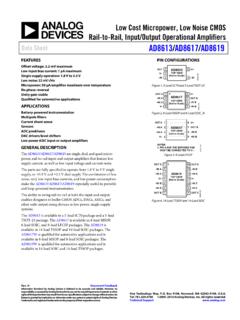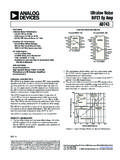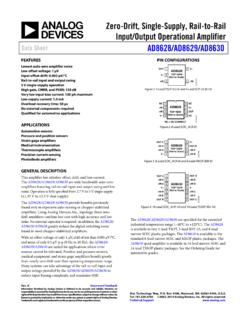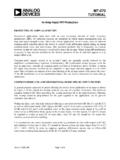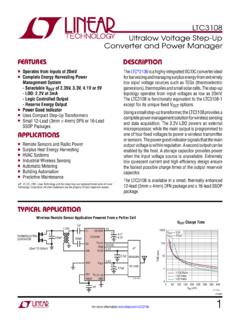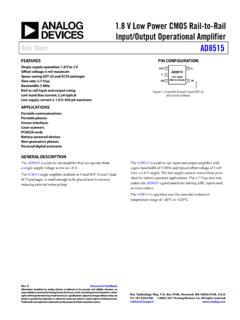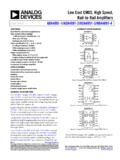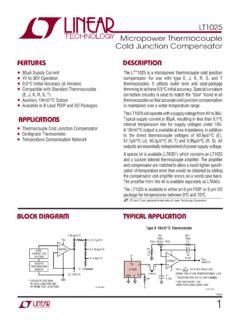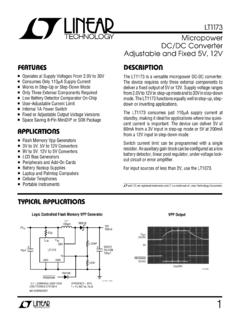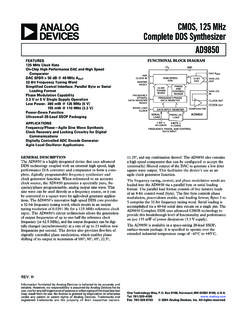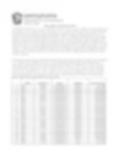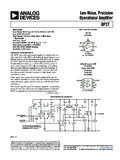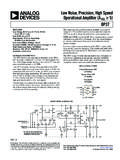Transcription of 1 nV/√Hz Low Noise Instrumentation Amplifier …
1 1 nV/ Hz Low NoiseInstrumentation AmplifierData sheet ad8429 Rev. A Document Feedback Information furnished by analog devices is believed to be accurate and reliable. However, no responsibility is assumed by analog devices for its use, nor for any infringements of patents or other rights of third parties that may result from its use. Specifications subject to change without notice. No license is granted by implication or otherwise under any patent or patent rights of analog devices . Trademarks and registered trademarks are the property of their respective owners. One Technology Way, Box 9106, Norwood, MA 02062-9106, : 2011 2017 analog devices , Inc. All rights reserved. Technical Support FEATURES Low Noise 1 nV/ Hz input Noise 45 nV/ Hz output Noise High accuracy dc performance ( ad8429 BRZ) 90 dB CMRR minimum (G = 1) 50 V maximum input offset voltage maximum gain accuracy (G = 1) Excellent ac specifications 80 dB CMRR to 5 kHz (G = 1) 15 MHz bandwidth (G = 1) MHz bandwidth (G = 100) 22 V/ s slew rate THD: 130 dBc (1 kHz, G = 1) Versatile 4 V to 18 V dual supply Gain set with a single resistor (G = 1 to 10,000) Temperature range for specified performance 40 C to +125 C APPLICATIONS Medical Instrumentation Precision data acquisition Microphone preamplification Vibration analysis PIN CONNECTION DIAGRAM TOP VIEW(Not to Scale) IN1RG2RG3+IN4+VS8 VOUT7 REF6 VS5AD842909730-001 Figure 1.
2 GENERAL DESCRIPTION The ad8429 is an ultralow Noise , Instrumentation Amplifier designed for measuring extremely small signals over a wide temperature range ( 40 C to +125 C). The ad8429 excels at measuring tiny signals. It delivers ultralow input Noise performance of 1 nV/ Hz. The high CMRR of the ad8429 prevents unwanted signals from corrupting the acqui-sition. The CMRR increases as the gain increases, offering high rejection when it is most needed. The high performance pin configuration of the ad8429 allows it to reliably maintain high CMRR at frequencies well beyond those of typical Instrumentation amplifiers. The ad8429 reliably amplifies fast changing signals. Its current feedback architecture provides high bandwidth at high gain, for example, MHz at G = 100. The design includes circuitry to im-prove settling time after large input voltage transients. The ad8429 was designed for excellent distortion performance, allowing use in demanding applications such as vibration analysis.
3 Gain is set from 1 to 10,000 with a single resistor. A reference pin allows the user to offset the output voltage. This feature can be useful to shift the output level when interfacing to a single supply signal chain. The ad8429 performance is specified over the extended industrial temperature range of 40 C to +125 C. It is available in an 8-lead plastic SOIC package. (nV/ Hz)FREQUENCY (Hz)1101001k10k100kG = 1G = 10G = 100G = 1k09730-002 Figure 2. RTI Voltage Noise Spectral Density vs. Frequency ad8429 data sheet Rev. A | Page 2 of 20 TABLE OF CONTENTS Features .. 1 Applications .. 1 Pin Connection Diagram .. 1 General Description .. 1 Revision History .. 2 Specifications .. 3 Absolute Maximum Ratings .. 6 Thermal Resistance .. 6 ESD Caution .. 6 Pin Configuration and Function Descriptions .. 7 Typical Performance Characteristics .. 8 Theory of Operation .. 15 Architecture .. 15 Gain Selection .. 15 Reference Terminal .. 15 Input Voltage Range.
4 16 Layout .. 16 Input Bias Current Return Path .. 17 Input Protection .. 17 Radio Frequency Interference (RFI) .. 17 Calculating the Noise of the Input Stage .. 18 Outline Dimensions .. 19 Ordering Guide .. 19 REVISION HISTORY2/2017 Rev, 0 to Rev. A Changes to Figure 2 .. 1 Change to Input Current Parameter, Table 1 .. 3 Changes to Figure 20 and Figure 21 .. 10 Changes to Figure 24 through Figure 27 .. 11 Changes to Figure 28 and Figure 30 .. 12 Change to Large Differential Input Voltage at High Gain Section .. 17 Changes to Figure 53 .. 18 4/2011 Revision 0: Initial Version data sheet ad8429 Rev. A | Page 3 of 20 SPECIFICATIONS VS = 15 V, VREF = 0 V, TA = 25 C, G = 1, RL = 10 k , unless otherwise noted. Table 1. A Grade B Grade Parameter Test Conditions/Comments Min Typ Max Min Typ Max Unit COMMON-MODE REJECTION RATIO (CMRR) CMRR DC to 60 Hz with 1 k Source Imbalance VCM = 10 V G = 1 80 90 dB G = 10 100 110 dB G = 100 120 130 dB G = 1000 134 140 dB CMRR at 5 kHz VCM = 10 V G = 1 76 80 dB G = 10 90 90 dB G = 100 90 90 dB G = 1000 90 90 dB VOLTAGE Noise , RTI VIN+, VIN = 0 V Spectral Density1: 1 kHz Input Voltage Noise , eni nV/ Hz Output Voltage Noise , eno 45 45 nV/ Hz Peak to Peak: Hz to 10 Hz G = 1 2 2 V p-p G = 1000 100 100 nV p-p CURRENT Noise Spectral Density: 1 kHz pA/ Hz Peak to Peak: Hz to 10 Hz 100 100 pA p-p VOLTAGE OFFSET2 Input Offset, VOSI 150 50 V Average TC 1 V/ C Output Offset, VOSO 1000 500 V Average TC 3 10 3 10 V/ C Offset RTI vs.
5 Supply (PSR) VS = 5 V to 15 V G = 1 90 100 dB G = 10 110 120 dB G = 100 130 130 dB G = 1000 130 130 dB INPUT CURRENT VIN+, VIN = 0 V Input Bias Current 300 150 nA Average TC 250 250 pA/ C Input Offset Current 100 30 nA Average TC 15 15 pA/ C DYNAMIC RESPONSE Small Signal Bandwidth: 3 dB G = 1 15 15 MHz G = 10 4 4 MHz G = 100 MHz G = 1000 MHz ad8429 data sheet Rev. A | Page 4 of 20 A Grade B Grade Parameter Test Conditions/Comments Min Typ Max Min Typ Max Unit Settling Time 10 V step G = 1 s G = 10 s G = 100 s G = 1000 5 5 s Settling Time 10 V step G = 1 s G = 10 s G = 100 s G = 1000 7 7 s Slew Rate G = 1 to 100 22 22 V/ s THD First five harmonics, f = 1 kHz, RL = 2 k , VOUT = 10 V p-p G = 1 130 130 dBc G = 10 116 116 dBc G = 100 113 113 dBc G = 1000 111 111 dBc THD + N f = 1 kHz, RL = 2 k , VOUT = 10 V p-p G = 100 % GAIN3 G = 1 + (6 k /RG) Gain Range 1 10000 1 10000 V/V Gain Error VOUT = 10 V G = 1 % G > 1 % Gain Nonlinearity VOUT = 10 V to +10 V G = 1 to 1000 RL = 10 k 2 2 ppm Gain vs.
6 Temperature G = 1 2 5 2 5 ppm/ C G > 1 100 100 ppm/ C INPUT Impedance (Pin to Ground)4 ||3 ||3 G ||pF Input Operating Voltage Range5 VS = 4 V to 18 V VS + +VS VS + +VS V OUTPUT Output Swing RL = 2 k VS + +Vs VS + +Vs V Over Temperature VS + +Vs VS + +Vs V Output Swing RL = 10 k VS + +Vs VS + +Vs V Over Temperature VS + +Vs VS + +Vs V Short-Circuit Current 35 35 mA REFERENCE INPUT RIN 10 10 k IIN VIN+, VIN = 0 V 70 70 A Voltage Range VS +VS V Reference Gain to Output 1 1 V/V Reference Gain Error % data sheet ad8429 Rev. A | Page 5 of 20 A Grade B Grade Parameter Test Conditions/Comments Min Typ Max Min Typ Max Unit POWER SUPPLY Operating Range 4 18 4 18 V Quiescent Current 7 7 mA T = 125 C 9 9 mA TEMPERATURE RANGE For Specified Performance 40 +125 40 +125 C 1 Total voltage Noise = (eni2 + (eno/G)2 + eRG2).
7 See the Theory of Operation section for more information. 2 Total RTI VOS = (VOSI) + (VOSO/G). 3 These specifications do not include the tolerance of the external gain setting resistor, RG. For G > 1, add RG errors to the specifications given in this table. 4 Differential and common-mode input impedance can be calculated from the pin impedance: ZDIFF = 2(ZPIN); ZCM = ZPIN/2. 5 Input voltage range of the ad8429 input stage only. The input range can depend on the common-mode voltage, differential voltage, gain, and reference voltage. See the Input Voltage Range section for more details. ad8429 data sheet Rev. A | Page 6 of 20 ABSOLUTE MAXIMUM RATINGS Table 2. Parameter Rating Supply Voltage 18 V Output Short-Circuit Current Duration Indefinite Maximum Voltage at IN, +IN1 VS Differential Input Voltage1 Gain 4 VS 4 > Gain > 50 50 V/gain Gain 50 1 V Maximum Voltage at REF VS Storage Temperature Range 65 C to +150 C Specified Temperature Range 40 C to +125 C Maximum Junction Temperature 140 C ESD Human Body Model kV Charge Device Model kV Machine Model kV 1 For voltages beyond these limits, use input protection resistors.
8 See the Theory of Operation section for more information. Stresses at or above those listed under Absolute Maximum Ratings may cause permanent damage to the product. This is a stress rating only; functional operation of the product at these or any other conditions above those indicated in the operational section of this specification is not implied. Operation beyond the maximum operating conditions for extended periods may affect product reliability. THERMAL RESISTANCE JA is specified for a device in free air using a 4-layer JEDEC printed circuit board (PCB). Table 3. Package JA Unit 8-Lead SOIC 121 C/W ESD CAUTION data sheet ad8429 Rev. A | Page 7 of 20 PIN CONFIGURATION AND FUNCTION DESCRIPTIONS TOP VIEW(Not to Scale) IN1RG2RG3+IN4+VS8 VOUT7 REF6 VS5AD842909730-003 Figure 3. Pin Configuration Table 4. Pin Function Descriptions Pin No. Mnemonic Description 1 IN Negative Input Terminal. 2, 3 RG Gain Setting Terminals. Place resistor across the RG pins to set the gain.
9 G = 1 + (6 k /RG). 4 +IN Positive Input Terminal. 5 VS Negative Power Supply Terminal. 6 REF Reference Voltage Terminal. Drive this terminal with a low impedance voltage source to level shift the output. 7 VOUT Output Terminal. 8 +VS Positive Power Supply Terminal. ad8429 data sheet Rev. A | Page 8 of 20 TYPICAL PERFORMANCE CHARACTERISTICS T = 25 C, VS = 15, VREF = 0, RL = 10 k , unless otherwise noted. 15 15 10 50510 15 10 5051015 COMMON-MODE VOLTAGE (V)OUTPUT VOLTAGE (V)G = 1VS = 15 VVS = 12 VVS = 5V09730-010 Figure 4. Input Common-Mode Voltage vs. Output Voltage, Dual Supply, VS = 5 V, 12 V, 15 V (G = 1) 15 15 10 50510 15 10 5051015 COMMON-MODE VOLTAGE (V)OUTPUT VOLTAGE (V)G = 100VS = 15 VVS = 12 VVS = 5V09730-011 Figure 5. Input Common-Mode Voltage vs. Output Voltage, Dual Supply, VS = 5 V, 12 V, 15 V (G = 100) + 50 45 40 35 30 25 20 15 10 50 14 12 10 8 6 4 202468101214 INPUT BIAS CURRENT (nA)COMMON-MODE VOLTAGE (V)09730-068 Figure 6.
10 Input Bias Current vs. Common-Mode Voltage FREQUENCY (Hz)0204060801001201401601101001k10k100k 1 MPOSITIVE PSRR (dB)GAIN = 1 GAIN = 1000 GAIN = 10 GAIN = 10009730-069 Figure 7. Positive PSRR vs. Frequency FREQUENCY (Hz)020406080100120140 NEGATIVE PSRR (dB)1601101001k10k100k1 MGAIN = 1 GAIN = 1000 GAIN = 10 GAIN = 10009730-070 Figure 8. Negative PSRR vs. Frequency 30 20 100102030405060701001k10k100k1M10M100 MGAIN (dB)FREQUENCY (Hz)GAIN = 1 GAIN = 1000 GAIN = 100 GAIN = 10VS = 15V09730-017 Figure 9. Gain vs. Frequency data sheet ad8429 Rev. A | Page 9 of 20 FREQUENCY (Hz)1020406080100120140160 CMRR (dB)101001k10k100k1MG = 1G = 10G = 100G = 1kBANDWIDTHLIMITED09730-110 Figure 10. CMRR vs. Frequency FREQUENCY (Hz)1101001k10k1M100k020406080100120140 CMRR (dB)G = 1G = 10G = 100G = 1kBANDWIDTHLIMITED09730-111 Figure 11. CMRR vs. Frequency, 1 k Source Imbalance 0246810120100200300400500600700 CHANGE IN INPUT OFFSET VOLTAGE ( V)WARM-UP TIME (s)09730-112 Figure 12.
